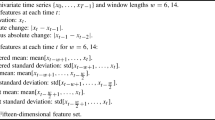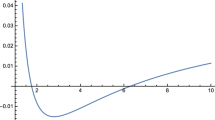Abstract
We study discrete price changes due to the size of a trade in the market microstructure model. We use a mixture of Poisson distributions to model the discrete changes in stock price. The parameters are estimated using the Expectation-Maximization (EM) algorithm with mixing probabilities which depend on order size. Consistency and asymptotic normality of a sequence of estimators are proved, and asymptotic confidence intervals for functions of the parameters are derived. We test the method with simulated and real data.
Similar content being viewed by others
References
Bank, P., & Baum, D. (2004). Hedging and portfolio optimization in financial markets with a large trader. Mathematical Finance, 14(1), 1–18.
Berlinet, A. F., & Roland, C. (2012). Acceleration of the EM algorithm: P-EM versus epsilon algorithm. Computational Statistics and Data Analysis, 56(12), 4122–4137.
Biais, B., & Weill, P.-O. (2009). Liquidity shocks and order book dynamics. In NBER working paper series (p. w15009). National Bureau of Economic Research.
Blekas, K., Likas, A., Galatsanos, N. P., & Lagaris, I. E. (2005). A spatially constrained mixture model for image segmentation. IEEE Transactions on Neural Networks, 16(2), 494–498.
Brijs, T., Karlis, D., Swinnen, G., Vanhoof, K., Wets, G., & Manchanda, P. (2004). A multivariate Poisson mixture model for marketing applications. Statistica Neerlandica, 58(3), 322–348.
Caudill, S. B., Gropper, D. M., & Hartarska, V. (2009). Which microfinance institutions are becoming more cost effective with time? evidence from a mixture model. Journal of Money, Credit and Banking, 41(4), 651–672.
Çetin, U., Jarrow, R. A., & Protter, P. (2004). Liquidity risk and arbitrage pricing theory. Finance and Stochastics, 8(3), 311–341.
Çetin, U., & Rogers, L. C. G. (2007). Modeling liquidity effects in discrete time. Mathematical Finance, 17(1), 15–29.
Cont, R., Stoikov, S., & Talreja, R. (2010). A stochastic model for order book dynamics. Operations Research, 58(3), 549–563.
Czado, C., Erhardt, V., Min, A., & Wagner, S. (2007). Zero-inflated generalized Poisson models with regression effects on the mean, dispersion and zeroinflation level applied to patent outsourcing rates. Statistical Modelling, 7, 125–153.
Dempster, A. P., Laird, N. M., & Rubin, D. B. (1977). Maximum likelihood from incomplete data via the EM algorithm. Journal of the Royal Statistical Society, Series B, 39(8), 1–3.
Fahrmeir, L., & Kaufmann, H. (1985). Consistency and asymptotic normality of the maximum likelihood estimator in generalized linear models. The Annals of Statistics, 13, 342–368.
Feng, W., Liu, Y., Wu, J., Nephew, K. P., Huang, T. H., & Li, L. (2008). A Poisson mixture model to identify changes in RNA polymerase II binding quantity using high-throughput sequencing technology. BMC Genomics, 9(Suppl 2), S23.
Gerdtham, G., & Trivedi, P. K. (2001). Equity in Swedish health care reconsidered: new results based on the finite mixture model. Health Economics, 10, 565–572.
Gill, R., Lee, K., & Song, S. (2007). Computation of estimates in segmented regression and a liquidity effect model. Computational Statistics and Data Analysis, 51(12), 6459–6475.
Golub, G. H., & Van Loan, C. F. (1996). Matrix computations (3rd Ed.). Baltimore: Johns Hopkins University Press.
Greenspan, H., Goldberger, J., & Eshet, I. (2001). Mixture model for face-color modeling and segmentation. Pattern Recognition Letters, 22(14), 1525–1536.
Harris, L. (1991). Stock price clustering and discreteness. The Review of Financial Studies, 4, 389–415.
Hernandez, J. A., & Phillips, I. W. (2006). Weibull mixture model to characterise end-to-end internet delay at coarse time-scales. IEE Proceedings. Communications, 153(2).
Madsen, H., & Thyregod, P. (2011). Introduction to general and generalized linear models. Boca Raton: Chapman & Hall/CRC Press.
McLachlan, G., & Peel, D. (2000). Finite mixture models. New York: Wiley Series.
Park, B. J., & Lord, D. (2009). Application of finite mixture models for vehicle crash data analysis. Accident Analysis & Prevention, 41(4), 683–691.
Petrov, V. V. (2001). Limit theorems of probability theory: Sequences of independent random variables. Oxford: Clarendon Press.
Rocha, M., Soldevilla, M., & Burtenshaw, B. (2007). Gaussian mixture model classification of odontocetes in the Southern California Bight and the Gulf of California. Acoustical Society of America, 121(3).
Rosu, I. (2009). A dynamic model of the limit order book. Review of the Financial Studies, 22(11), 4601–4641.
Su, K., Chen, J., Lee, J., Hu, C., Chang, C., Chou, Y., et al. (2011). Image segmentation and activity estimation for micropet 11c raclopride images using an expectation-maximisation algorithm with a Poisson distribution. Computerized Medical Imaging and Graphics, 35, 417–426.
Xu, L., & Jordan, M. (1996). On convergence properties of the EM aagorithm for Gaussian mixtures. Neural Computation, 8, 129–151.
Yao, W. (2013). A note on EM algorithm for mixture models. Statistics & Probability Letters, 83(2), 519–526.
Zeng, Y. (2003). A partially observed model for micromovement of asset prices with Bayes estimation via filtering. Mathematical Finance, 13(3), 411–444.
Zhai, C., Velivelli, A., & Yu, B. (2004). A cross collection mixture model for comparative text mining. In Proceedings of the tenth ACM SIGKDD international conference on knowledge discovery and data mining (pp 743–748).
Author information
Authors and Affiliations
Corresponding author
Rights and permissions
About this article
Cite this article
Jayasekare, R.R., Gill, R. & Lee, K. Modeling discrete stock price changes using a mixture of Poisson distributions. J. Korean Stat. Soc. 45, 409–421 (2016). https://doi.org/10.1016/j.jkss.2016.01.002
Received:
Accepted:
Published:
Issue Date:
DOI: https://doi.org/10.1016/j.jkss.2016.01.002




